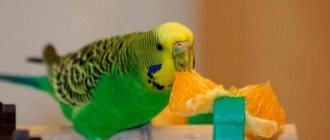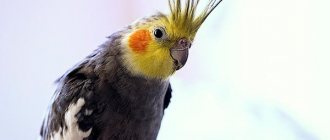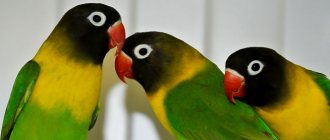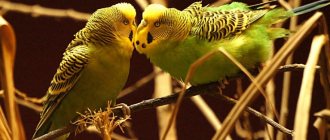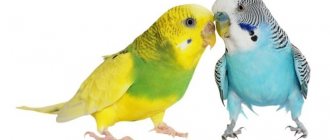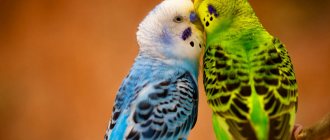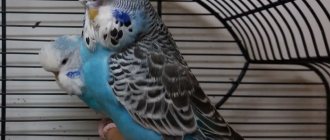Conditions for breeding
Having decided to breed parrots, it is advisable, in addition to the knowledge and acquired all the necessary accessories, to have several pairs of budgies. In case of failure with the clutch/chick, you will have a chance to save the future offspring and at the same time help restore the health of the female/male.
Let's take a closer look at how budgerigars are prepared and bred.
Photo: Timothy Burling
Firstly, the male and female must be a mature couple and absolutely healthy. The optimal age of birds is from 1.5 to 5 years (a parrot can be older than 5, but not younger than 12 months). These should not be parrots from the same breeder - the risk due to inbreeding is fraught with genetic diseases with their manifestation in severe defects.
Birds should not be allowed to lay during molting, are overweight or are physically exhausted!
In breeding, the time of year for domestic budgies does not play such a decisive role as in the wild. Natural nesting for these birds begins in Australia in the summer, at a time when we have winter. Seasons that are popular with breeders are: late spring and summer – long days, all kinds of vitamins available and optimal air temperature.
In any case, you decide when to change the feeding pattern and daylight hours of your wavy. Also, in addition to the time of year and weather, one has to take into account the personal calendar of business and vacation, since the time of hatching eggs and raising chicks means round-the-clock care and readiness to provide appropriate assistance to the “young family” and its offspring.
Basics of Breeding Budgerigars
In captivity, there are usually no problems with parrots mating, but there are nuances that should be taken into account before breeding.
- Decide on the gender of your pet. If you have a pair or more, then determine the gender of all individuals;
- Birds suitable for breeding are a year old, or preferably one and a half years old. Birds that are too young or too old will not produce healthy offspring;
- The couple must be absolutely healthy;
- To breed, birds need long daylight hours and warmth, such as summer or early autumn;
- You need to put a breeding house for budgerigars in the cage, in which the female will hatch the eggs.
Reproduction of budgies at home video
You cannot force birds to mate; they must like each other.
What to do if a couple lives for a long time, but there are no offspring? The following reasons are possible: they have the same sex, there is no contact between parrots, or they are not yet ready to bear children.
Parrot breeding as a business
How to breed budgies so that it generates income? You should have more than one pair, or even two. Accordingly, you will not be able to keep all the birds at home and you will need a separate room for this. Moreover, birds must lay eggs regularly. And keep in mind that during the period of laying and pregnancy, the female needs to be fed and the amount of food consumed increases significantly.
It is not difficult to calculate future income; each clutch contains from 4 to 6 eggs or more, each chick costs from 500 to 2000 rubles. The price depends on gender, boys are traditionally more expensive, age and level of communication with a person. Tame budgies are more expensive. It is worth remembering that not all eggs can be fertilized, and not all will hatch into chicks.
Even if everything goes well and you have a constant supply of young offspring, you need to sell them somewhere. Therefore, before you start breeding, think about where you will take your wavy animals. The best option would be ad sites like Avito, Yula, and breeder forums. You can also sell it at the market or take it to a pet store.
Advantages of breeding parrots at home
- Budgerigars are highly sought after in the market;
- Keeping birds is not expensive;
- You must have at least one pair ready to mate.
Disadvantages of breeding parrots at home
- Low cost per individual
- If there are more than two couples in the apartment there will be unbearable noise
- Regular examinations of birds for diseases and injuries, cleaning of the cage
- Before going on vacation, the problem always arises: who to leave the birds with.
How to breed budgies at home
The matching pair is placed in a cage and observed. After some time, the male should begin to show attention to the female and care for her. If the male suits her and she is ready to mate, she will respond to courtship. During the mating season, birds clean each other's feathers, feed their partner from the beak, and dance. Readiness for mating is determined by the change in color of the cere to brown on her and the color of the chin on him to blue. After this, the parrots begin to mate. In young individuals everything goes quickly; older individuals can mate for a long time and more than once. After mating, you need to change the female’s diet and add protein products such as cottage cheese or boiled eggs, as well as introduce more vegetables and add vitamins A, D, add mineral stone and sepia.
Breeding budgies at home video
Pregnancy lasts 10 - 14 days. During this time, you need to prepare a house for budgies. Be sure to treat it with boiling water or a disinfectant, fill the nest with sawdust and twigs for the nest. When the house is ready, place it in a cage so that the female can restore order there before laying eggs.
Budgerigar pregnancy
Most often, pregnancy occurs after mating, but there are exceptions, so focus on the behavior of the female, which, if successful, will quickly change.
Symptoms of pregnancy:
- Aggression
- Decreased appetite
- Change in quantity and color of droppings
- The bird is getting bigger
- When examined and palpated in the area of the ribs, you can feel a compaction.
Once you have determined that you are pregnant, wait for the laying to begin. By the end of the second week, the bird will spend more time in the nest.
The beginning of masonry can be determined by the following signs:
- The litter becomes larger and its quantity reaches 10% of the female’s weight
- The smell of the droppings is pungent
- Hard breath
- The bird constantly pecks at the sepia
- Cloaca expands
- Sleeps more
- The feathers from her belly fall out (brooding spot), and she will use this bare belly to warm her eggs.
As soon as the female has stayed in her house for a long time, we can say that the bird has laid eggs and the breeding of budgerigars has been successful. Please note that laying does not occur in one day, but every day an egg. Be prepared for the fact that not all eggs will be fertilized and a couple of eggs will have undeveloped embryos - this is normal. Unfertilized eggs become yellowish or grayish over time. But don't remove them from the nest. They will serve as an additional source of heat. But eggs with a non-developing embryo need to be removed so that the female does not accidentally throw away healthy ones with them. It’s worth thinking about when the entire masonry dies. The issue may be the health of the parrots, an inadequate diet or an inappropriate mating time.
Hatching of the eggs lasts about 18 days and all this time the male takes care of the female and helps her with incubation.
It happens that a bird cannot lay eggs. She gets ruffled and doesn’t go into the house. In this case, she needs to be given vegetable oil. If it doesn’t help, then most likely the egg was not formed correctly or is too large, or the bird is too young and has not developed the muscles of the oviduct. In this case, consult a doctor immediately.
Preparation for masonry
Most often, owners of budgerigars begin to prepare the birds for nesting about two weeks before installing the nest house in the cage.
Make sure that the cage is in a quiet and peaceful place and do not disturb the birds unnecessarily during this period of time.
The room temperature should be no lower than 15 C, daylight hours should be 14-16 hours (if necessary, add artificial lighting with a smooth transition so as not to provoke molting in birds). Heat is also dangerous for embryos, so the upper limit of air temperature should also be controlled.
Disinfection
Be sure to disinfect all items you will need during this time. The cage, drinkers, feeders and toys are soaked in hot water with a weak bleach solution, and then rinsed thoroughly. The house itself is disassembled, cleaned with baby soap, dried, then calcined in the oven at 120 degrees for 30-40 minutes, some, after a good bath of the nest, calcine it on a gas burner until the outer wall becomes hot - it all depends on how and what it is made of.
It would be a good idea to add dry medicinal chamomile to the sawdust that you will add to the nest - it prevents the appearance of gamas mites.
Preparing the cage and nest
Breeding budgies requires careful preparation of the cage and all its elements. For example, a female, preparing for maternal responsibilities, begins to gnaw on everything she can reach. To avoid damage to cage parts and other accessories, it is recommended to put a vitamin stone and several twigs. Let her fulfill her need on them.
Each specialist recommends his own cage sizes. However, the minimum parameters are 40x30x40 cm. Insufficient space can interfere with the appearance of offspring. And if it is born, they may experience the aggression of their parents.
The cage is placed at eye level of the owner, this makes the birds safer and calmer. You should not place it near a microwave oven or gas stove.
The room where you decide to keep the parrots should be well ventilated, but at the same time avoid drafts. As soon as the parrots begin the nesting period, do not move the cage, do no repairs in this room, and do not produce sounds unusual for birds.
We recommend reading: TOP 10 best food for budgies
For the hygiene of the mother and future offspring, disinfection and sterilization are necessary: wipe with “White” and rinse the drinking bowl, feeder, and cage in warm water. The nest is washed using baby liquid soap, dried and heated in the oven at a temperature of about 130 degrees for 40 minutes. Mix sawdust with chamomile. This will repel gamas ticks.
Nutrition
Some breeders cut back the parrot's menu a little to play on the birds' natural instincts when they later receive a rich, vitamin-rich diet. But this is not a generally accepted method.
The couple’s daily diet, in addition to grains, seeds, vegetables, fruits and herbs, should include porridge, steamed and sprouted grains (high content of vitamin E, promotes reproduction), calcium, mineral supplements, an egg (preferably quail) and cottage cheese with 2% fat content.
The diet of birds should always be varied, regardless of whether you intend to breed parrots or not.
It is very important that your parrots eat all foods.
If you have not taught your parrot to eat anything other than a few types of grains and carrots with an apple, breeding parrots in this case is strictly prohibited!
Your birds simply do not have enough nutrients for normal egg gestation, successful laying and feeding of the chicks. Even if offspring appear under such conditions, they will have a very high risk of being born disabled and the development of the birds will not go as expected.
During nesting, the female’s body requires increased nutrition, enriched with additional products.
To lay a full-fledged egg and form a healthy embryo, in addition to the standard diet, breeders feed parrots every other day with a mixture of carrots, eggs and cottage cheese (a source of calcium) and sprouted grains - mash.
You should not enrich the birds’ diet in this way every day, since an excess amount of protein affects hormonal levels and birds can become aggressive towards each other and the chicks, as well as get gastrointestinal problems.
Photo: Michelle M.
Examples of mash for budgies during the breeding season:
– carrots+apple+boiled egg+rice porridge+greens;
-sprouted grains: green lentils, millet, wheat, oats, hemp seed + grated beets + egg;
- boiled millet and oats + rice and pearl barley + beets + egg + greens;
– sprouted grains + sweet peppers + hamarus;
– steamed cereal + zucchini + carrots + egg + greens;
– cottage cheese + pumpkin + broccoli + sprouted wheat + greens.
Some breeders like to add gamarus as a seasoning (freshwater crustaceans are a natural animal protein that can only be used during the breeding season and in small quantities), but this is not necessary, it is enough that you alternate the egg with sprouted grain food.
Pay attention to how budgies eat sepia, mineral stone and mineral mixture, which should always be in the cage. If your birds are not interested in them, you will have to use crushed calcium gluconate tablets as a source of calcium and add them to mixtures. This will help avoid the fragility of the eggshell and allow the embryos to develop safely.
As soon as the female begins to hatch eggs, eliminate soft food from the parrot's diet and double the amount of grain. The egg should now be given in very small quantities and very rarely.
1-2 days before the chicks hatch, the female needs to be fed again with an egg, carotene-containing vegetables (carrots, pumpkin, sweet peppers), herbs and sprouted grains.
We will look at what to feed budgerigar chicks in this article.
After two weeks of preparation, you can install the nest house. You will find out what a nest for budgerigars should be like here.
During nesting, parrots should not be allowed out of their cage for a walk.
Matching
To be successful in breeding budgies, you should pay attention not only to the age and health of the birds. It is advisable to select future parents of chicks from different families that are not united by common genetics. This will avoid anomalies in the health of the offspring.
We recommend reading: How many days do budgies hatch eggs?
Some experts allow males and females to find their own mates, keeping a whole group of different-sex parrots in one large cage. When they find a companion and partner on their own, this will save the owner from the hassle and unsuccessful attempts. Because there are cases when a female behaves aggressively with her intended partner, and they do not have the prerequisites for mating and offspring. Time is lost, and the owner needs to go and look for the next candidate, hoping for success on the second or third try.
They suggest checking the unity of characters when meeting in the following way:
- Place the prospective couple in adjacent cages.
- If the candidates are attracted to each other, let them fly together on neutral territory.
- Launching birds into one cage.
The location of the male budgerigar and the female can be seen by the following signs:
- he tries to clean her feathers, feeds her from his beak, coos like a dove;
- she nods her head and kisses the future dad of their children. Even if there are several other parrots in the cage, the female stays close to her gentleman.
Male courtship
During the mating season, the male's cere becomes a rich blue color, while the female's is brown, even slightly enlarged. This is a sign of raging hormones. The male's courtship becomes more intrusive; some females hardly eat until the male feeds them, although they themselves are not yet sitting in the nest.
Photo: Matt Francey
It is very interesting to watch the wavy couple cooing before mating. The male begins to actively nod his head, chirp, and dancing and chatting begin - the parrot knocks with its beak on all objects and on the beak of the female. Sometimes the female takes part in the dance. Making all kinds of sounds, the male does not forget to treat the young lady with food from his beak. This ritual seems to confirm the seriousness of the male’s intentions. After all, after the female goes to the nest to incubate the eggs, the male becomes the main breadwinner and guard.
Incubation period for budgie eggs
The incubation period of eggs lasts 18 days.
A week after the first mating, the first egg appears in the nest. From the moment the first egg is laid, the female begins to linger in the nest, but she “sits” somewhere after the second egg.
Before laying an egg, the parrots begin to chew chalk noticeably more, the female gets better, and her litter increases. The bird becomes very funny, round with its tail quivering upwards. She spends a long time fumbling around in the corner of the cage, building a nest, and has a desire to gnaw on everything.
At this time, the female develops a brooding mark - the feathers on her belly fall out, the rest begin to puff up due to the fact that the skin swells and warms up. This is where the female will warm her eggs.
Photo: SurlyTheGrouch
Egg laying occurs every other day. Depending on the age of the bird, it can lay up to 12 eggs. But this is rare, most often there are about 7 in a clutch, but the optimal number is 5. Then the female budgerigar will be able to evenly warm all the offspring and the number of frozen eggs will be close to zero. If your female has laid more than 5 eggs, you can place them in the nest of a neighboring pair of budgerigars or use an incubator for this.
It happens that the owner comes as a surprise when a female budgerigar lays an egg. Sometimes it lies at the bottom of the cage because you have not intended to put up the house yet. You will learn in more detail what to do in such a situation in this article.
Experienced breeders can identify fertilized eggs without candling: unfertilized eggs acquire a yellow tint a few days after incubation, while fertilized eggs, on the contrary, become porcelain, white-gray in color.
Unfertilized eggs should not be removed from the clutch, as they act as a heating pad in the absence of a female. Frozen ones, with an embryo inside, must be removed (they can be recognized by their gray-brown color with spots). The bird can do this itself, but by mistake throw away normal eggs.
Be sure to hang a bathing suit in the cage: if the air is too dry, the female maintains the required humidity in the nest with the help of wet feathers.
Nesting period
The nesting period includes several important moments: from mating to the appearance of chicks. Depending on whether mating took place quickly or within two weeks, the wait for the young can last up to a month.
Pairing
Ornithologists note that mating of budgerigars can be one-time and sufficient for fertilization and the appearance of offspring. As a rule, the owners do not notice the rapid mating process. But sometimes mating games of budgies are repeated within 1-3 weeks.
Behavior of a pregnant female
After mating, the female's behavior begins to change. Ready to lay her eggs, she begins to familiarize herself with the nesting site. First, she looks at the nest from afar, stretching her neck. After some time, feeling that there is nothing to be afraid of, the female begins to slowly approach him. Depending on her character traits, sooner or later the female flies inside the house and begins to settle in there: gnawing on the walls and throwing out what, in her opinion, is unnecessary.
We recommend reading: Why does a budgerigar's beak peel off?
Hatching offspring
It is necessary to ensure that none of the fertilized eggs is left unwarmed. Hatching lasts up to three weeks. If during this period some of the eggs do not hatch, they are removed. It happens that some chicks die after hatching. To detect and remove them, the house is checked 2-3 times a week.
Determination of egg quality
In simpler terms, this procedure is called ovoscopy. A week after laying, the eggs are checked. Fertilized ones have a matte tint, while unfertilized ones have some gloss in appearance and the color is mottled or yellowish-white.
Among the known defects are the following:
- blood clots in the egg;
- the embryo dries to the shell wall;
- the yolk and white are mixed;
- foreign objects enter the egg while still in the female’s oviduct;
- the air chamber in the egg moves;
- mold spots inside.
The appearance of chicks
The chicks are born blind and very weak. The body is completely naked, the opening of the eyes occurs after 6 or 7 days. But they can concentrate their gaze only 3 days later.
If a mother behaves aggressively towards her children, the babies are immediately removed. The female begins to leave the nesting site about two weeks after the chicks appear and returns to her usual quiet life.
The first chick hatches much earlier than the last one. The gradual laying of eggs is the reason for the extended hatching and maturation of the chicks.
Reasons why the clutch turned out without fertilized eggs or with frozen
When there are one or two frozen eggs in the clutch, there is no need to worry. Even due to inexperience, the female may not have warmed all the eggs evenly. If all the offspring died, it is worth thinking about the reasons.
These could be infectious diseases of parrots, improperly formulated bird nutrition, poor-quality water, genetic incompatibility of parents, inappropriate humidity in the apartment, or the female is not able to hatch eggs normally.
As for unfertilized eggs, the most common reason is that the birds were not properly prepared by the breeder. But it happens that the reason lies in health problems in one or both parrots. Even the wrong location and quality of the perches can affect the result.
Is it worth interfering?
Many breeders are able to let go of the situation after installing the nest house and let the birds deal with the offspring themselves. A fleeting inspection of the nest several times throughout the entire period seems sufficient to them. But such people are a minority; the rest simply cannot resist, and there are two reasons for this: excitement for their pets and interest in the process.
Some owners, when breeding budgies, get very carried away and can bore their own birds. This manifests itself in constant peeping into the nest, persistent adding of sawdust when the female throws it out anyway, and after laying, regular inspection of the eggs is added.
It is important to listen to the behavior of a pair of budgies, especially the female. If you see that she is clearly nervous and becomes aggressive when you put your hand in the nest, you should not make the bird nervous with your presence. If there is an urgent need, wait until she leaves the nest and takes care of the feeder with grain.
You should handle the eggs very carefully. It is better not to pull them out of the nest unless necessary.
More experienced breeders number each egg with a soft pencil so that they can control the sequence of appearance of the chicks. If you have already hatched two chicks, and egg number 1 is still in the nest, there is a high probability that something went wrong and the embryo died.
Before putting your hands into the nest, you can rub your hands with chamomile; some females cannot tolerate foreign odors during the laying period. And they may, in the future, abandon the chicks after you touch them.
Photo: Melanie Schmidt
Budgerigar chicks are born every other day. At this moment, the humidity of the room plays a very important role (the norm is more than 60%). Thanks to this, the chicks can get out of the egg on their own. There is a thin film under the egg shell, and if the air is too dry, it instantly dries to the newborn, which leads to the death of the parrot.
Babies have an “egg tooth” on top of their beaks, with which they break through the wall of the shell. The female can also sometimes participate in the process: as soon as the chick makes a small hole, she begins to help him free himself from the remains of the egg. The shells are usually eaten by females. It happens that curious owners themselves try to help the chick get out of its home; this can only be done if you are confident in the incubation period and there is a professional ornithologist next to you who shares your zeal to participate in the process.
Newborn chicks bear little resemblance to their adult parents: blind, naked, with only a little gray fluff on their backs. At first, babies are so helpless and weak that they are unable to hold up their heads and lie on their backs. The female feeds them in this position. At this time, she is constantly next to the chicks, and, warming with her body, does not allow the babies to freeze.
Photo: PuppiesAreProzac
Just a hatched budgerigar chick weighs 1 gram; babies of exhibition budgerigars most often weigh more than 1.5 grams.
Since the chicks do not hatch at the same time, and their development occurs very quickly, then, by the time the last chick appears, the older one will already be quite large compared to the younger one. If there were more than five eggs in the clutch, and the female successfully hatched all the offspring, there is a high risk that the grown chicks may crush the babies.
How to choose a pair
When thinking about choosing a partner for birds, they often forget about the usual feeling of sympathy, which is very important for parrots. Yes, they, like people, can fall in love, so expecting children from birds who are indifferent to each other is, to say the least, naive. That is why one of the most important conditions for breeding budgies at home is reciprocity. What should you do to find the perfect match? Read on.
When choosing, pay attention to mobility, full plumage, feather color, general physical development, etc. Birds should be strong, but not fat. Weak ones should not be allowed to mate: they do not really sit through the clutch and may not tolerate reproduction well.
When buying birds, choose those who pay attention to each other even in the common aviary. Before breeding budgies, be sure to find out the degree of relatedness of the purchased birds. A blood relationship between a male and a female can greatly impair the health of the young. It is a great idea to buy birds from different breeders.
You must be 100% sure that you have an opposite-sex couple. To avoid trouble, it is best not to buy chicks under 4 months of age. The age of the birds is also very important. Despite the fact that parrots can breed from 5-7 months, you should not plan mating before a year, because the female’s fragile body can endure the first clutch very painfully, which can lead to serious illness and even death of the pet.
If well-maintained, parrots can mate at 8-9 years of age, but the chicks born will be clearly weaker than their same-year-old counterparts from young parents.

